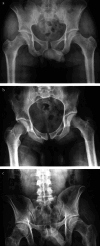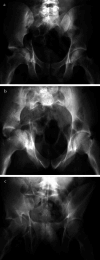The myth of 2.5 cm symphyseal diastasis
- PMID: 40397156
- PMCID: PMC12095382
- DOI: 10.1007/s00402-025-05904-x
The myth of 2.5 cm symphyseal diastasis
Abstract
Detection of disruption of the pubic symphysis and resulting anterior pelvic ring instability primarily depends on the symphyseal widening on standard anterior-posterior X-rays. Based on biomechanical and clinical analyses from the 80 to 90's, a cut-off value of 2.5 cm widening distinguished between stable and unstable lesions. A relevant debate developed concerning minor (< 2.5 cm displacement), moderate (> 2.5 cm displacement) and severe disruptions (> 2.5 cm displacement + posterior complete pelvic ring instability) of the pubic symphysis. Analysis of anatomic, biomechanical, physiological and clinical literature showed, that an exact value does not allow this differentiation. Thus, symphyseal posttraumatic disruptions with displacements > 10 mm should be treated surgically, while in minor displacements (5-10 mm) stress examination can guide adequate treatment.
Keywords: Consequences; Instability; Pubic symphysis; Symphyseal physiology; Symphyseal width.
© 2025. The Author(s).
Conflict of interest statement
Declarations. Conflict of interest: No author has a conflict of interest that relates to the content discussed in this manuscript. All authors have contributed to and read the paper and have given permission for their names to be included as an author. The manuscript has not already been published and will not be submitted or published simultaneously elsewhere.
Figures







References
-
- Gänsslen A, Lindahl J, Grechenig W (2021) Chapter 21: Symphyseal disruption. In: Gänsslen A, Lindahl J, Grechenig S, Füchtmeier B (eds) Pelvic ring fractures. Springer Nature, Cham, pp 285–306. 10.1007/978-3-030-54730-1_23
-
- Trafton P (1993) Fixation of the pubic symphysis. Oper Techn in Orthop 3:13–18
-
- Pohlemann T, Gänsslen A (1999) Die Operation der Symphysensprengung. Oper Orthop Traumatol 11:149–159 - PubMed
-
- Lindahl J, Hirvensalo E, Bostman O, Santavirta S (1999) Failure of reduction with an external fixator in the management of injuries of the pelvic ring. Long-term evaluation of 110 patients. J Bone Joint Surg Br 81:955–962 - PubMed
-
- Berner W, Oestern H, Tscherne H (1984) Die hintere Beckenringluxation - eine Indikation zur operation. Hefte Unfallheilkd 164:286–291
Publication types
MeSH terms
LinkOut - more resources
Full Text Sources

